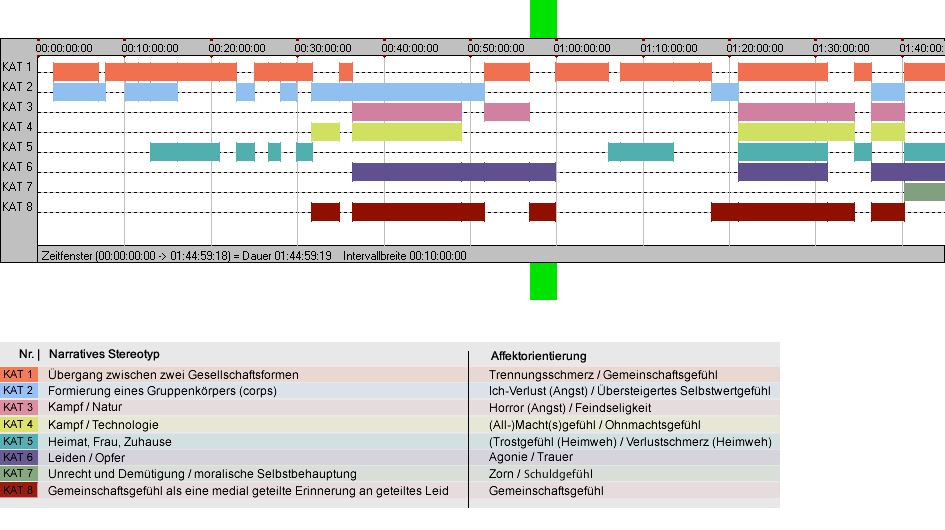Victims after the battle*
Classification in categories
- Suffering / victim / sacrifice
- A sense of community as the shared filmic remembrance of shared suffering
Please enable JavaScript in Your browser.


Metadata
Movie: Sands of Iwo Jima*
Number: 19
Individual analysis: Sands of Iwo Jima*
Timecode start: 00:56:49:07
Timecode end: 00:59:49:24
Year of origin: 1949
This scenic expressive movement comprises four clearly discernable expressive movement units that are also individually marked by the musical score. First, the decreasing movement of the exhausted surviving soldiers is shown as well as the dead and wounded who have come to rest—up to a state of complete motionlessness (>EMU 1). In contrast to the soldiers’ uncoordinated, viscous movement, the second set of shots shows soldiers marching in rank and file, whereby their dirty faces and uniforms indirectly reference their exhaustion (> EMU 2). The accompanying music is first elegiac and then more muffled, with a clear rhythm that matches the pace of the march and seemingly summons the soldiers’ last reserves of energy. The transition to an upward pan of the American flag thus becomes a pathos scene: Despite their bodily exhaustion, the soldiers are pushed to their physical limits to fight for their country.Number: 19
Individual analysis: Sands of Iwo Jima*
Timecode start: 00:56:49:07
Timecode end: 00:59:49:24
Year of origin: 1949
The music, with the change to the Marines’ hymn, underscores the camera movement and makes the stream of marching soldiers seem to be an extension of the vastness of the sky, indentifying them with the resplendent flag waving in the wind. The images that follow immediately reframe the image, fading (accompanied by a musical background that is again elegiac with the Marines’ hymn changed into a minor scale) into a shot composition that shows, framed by two horizontal bars, the far horizon of the ocean reflecting the setting sun (> EMU 3). The quadratic American flag fades into another quadratic frame, so that the sensation of vast distance melds with a moment of sublimity. In this way the nation is equated with the sublime. The documentary material that follows is thus given a solemn and ceremonious character. It shows a burial ritual on the ship (from a bird’s-eye perspective) whereby a coffin is draped in a large Stars and Stripes. The flag undergoes a transition from a small package carried in a soldier's breast pocket, to a symbol of the ascendancy of the nation erected in a foreign country to the coffin that slides out of the shelter of the flag and is relinquished to the ocean (which in its vastness stands for the infinitude of death). Successively, a chain of sensory impressions is thus created: From a symbol of national ascendancy carried over an individual heart to collective mourning. It can be experienced not only on the semiotic level, but also on the perceptual and affective level. Furthermore, the interspersed documentary material contributes to the experience of a collectively supported image of history; its impression of providing an overview aided by the bird's eye perspective.
This is the context within which the soldiers' gazes in EMU 4 are brought together, in which again the individual body is linked to the military group. The separate downward gazes of the individual soldiers create a group body because of the conflation of the grouped soldiers with collective, as well as individual (Thomas’), feelings. The soldiers' empty gazes are expressive and their faces can be interpreted in many ways: melancholy, mourning, self-reflection, antagonism, regret, etc. When Thomas’ and Stryker’s faces are juxtaposed, after a time lag, in the same position, but referencing different emotional reactions due to their differing experiences, they seem almost symbiotic, like one soldier, as if to say: “We’re all in the same boat.” Just as the soldiers, despite their exhaustion and their sacrifice (>EMU 1) must continue to march after the battle (>EMU 2) , the mourning soldiers must renew their motivation, supported by a new musical key when Stryker, by issuing sake supposedly taken from a dead Japanese soldier, gives out hostile fighting spirit so that the Marines can continue to march and to battle. This unending motif of movement goes hand in hand with the scenic expressive movement, which can be described as one continuous movement created out of the different filmic tools of composition. HJC
Expressive movement units
01 02 03 04Materials about the scene
Position of the scene in the film





